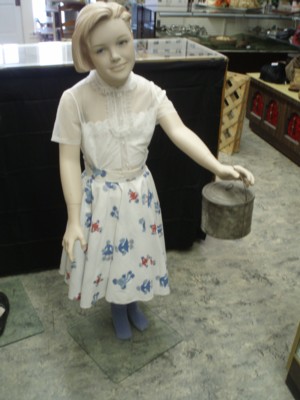Hot Lunch for Everyone
 By
By
Marge Coonen
Back in the the good old days, when there were about 16 rural schools in the Seymour area, an outdoor school bell would be rung by hand to call the students . Today, the school bells ring automatically. They did not have school buses, so the children walked. They didn’t have automatic heat, the teacher would starting the wood burning in the black-jacketed stoves as soon as she arrived for the day’s classes. They did not have running water, the boys brought in the wood to burn, and the water to drink. They had no choice for hot lunch nor did they have a choice for a status plastic lunch box. Students carried their own lunch to school in old syrup pails. The Seymour Museum has some of these tin pails on display.
In big cities and rural areas there was a great concern among the citizens to feed hungry and needy children in school. They felt strongly that a child could not learn on an empty stomach.
Rural schools had a special problem in attempting to establish warm noonday lunches for the pupils. There was no room in a one room school house available for setting up a kitchen and dining area. Children came to school from long distances, and their lunches at noon consisted mainly of cold sandwiches, many of them had little nutritive value. During the Depression the sandwich might be just home-made bread with lard for the filling.
Efforts were made beginning in the early 1900’s to provide some means of warming certain foods brought from home. Many ingenious teachers would prepare soups or hot dishes from meat and vegetables brought to school by students. Such items were cooked in a large kettle set on top of the stove which also heated the school room.
Doris Wussow wrote in Encore, the Seymour Historical Review, that was published in 1998.
“It was usually very cold in the school room on these days. We would move the desks as close as possible to the big black-jacketed stove and proceed to study or have class. Feeling sorry for us on these cold days, parents would send vegetables or a soup bone along to school so we could have a “hot meal”. The older students would prepare the vegetables and then add them to the already boiling soup bone, we had to be very careful as our cooking was done on a kerosene stove, but everyone cooperated and at lunch time vegetable soup was enjoyed by all”
Wisconsin had a program at the time known as “the pint jar method”. It was used in heating foods that the students brought from home. Students were encouraged to bring some items as soups, macaroni, cocoa etc in a pint jar. The pint jars were set into a bucket of water on top of the room heater and by lunch time such food would be piping hot. Much stress was placed upon the importance of students receiving some hot food at school each day to supplement the cold sandwiches which were usually frozen solid by the time the child got to school.
After World War II, in 1946, President Harry S. Truman signed the National School Lunch Act. This provided nutritionally balanced, low cost or free lunches to children each school day. The program not only benefits children who participate, but also contributes to the agricultural and national economy as well as to the total education process.
In 1952, The Seymour Union High School District was formed. It included Nichols, Cicero, Isaar, Black Creek, Center Valley and Seymour. Planning began for the construction of a new high school on the south side of town. In the plans was a multi-purpose room equipped with a kitchen and the Seymour School District went about hiring its first school cooks. Milton Patchett was the Superintendent of Seymour Schools, and he hired Mrs. Bud Mc Bain, as head cook. Her helpers with the program were Mrs. Philip Eick, Mrs. Mabel Schlack, and Mrs. Ed Landwehr. The date was Monday, November 9, 1954. The National Hot Lunch Program had finally come to Seymour.
In the 1956 “Ripper” it is stated:
“All activity came to an abrupt halt at 11:52 when hot lunch was served. After lunch and before classes resumed the students took part in either playing basketball, table tennis, cards and chess, or dancing”